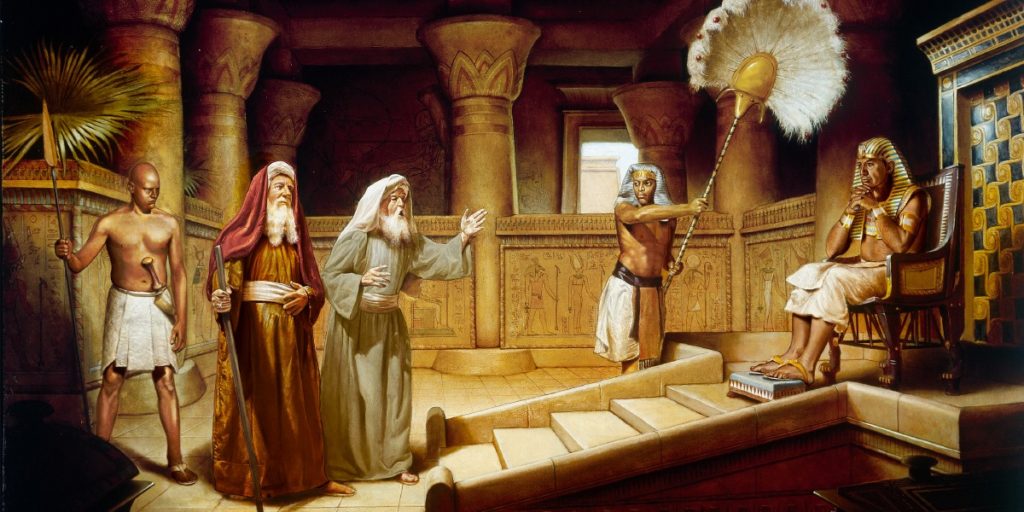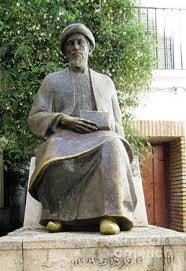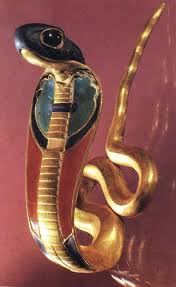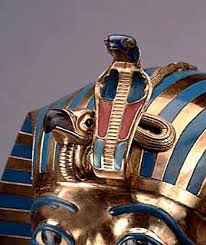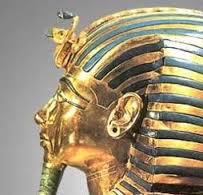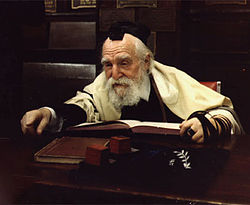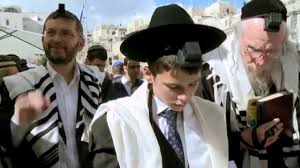“Just as, according to what I have told you, the doctrines of the Sabians are remote from us today, the chronicles of those times are likewise hidden from us today. Hence if we knew them and were cognizant of the events that happened in those days, we would know in detail the reasons of many things mentioned in the Torah”
Maimonides: Guide for the Perplexed, III, 49
Today, we have much more archeological knowledge about past origins than the Rambam. Had he been living today, there is no doubt that he would have taken an interest in modern archeological discoveries. The tomb of Tutankhamen was not opened for 3000 years. It was the only tomb which was ever discovered that was not emptied out of its contents by grave robbers. Howard Carter discovered this tomb in 1923 and it was one of the most celebrated discoveries in archeology ever. Here we find the Ureaus, the Cobra and the Vulture, the headdress which Pharoah wore, in tact in its original colors and beauty. It was the symbol of Pharaoh power and supremacy in all of Egypt. Only the Pharoah and his wife wore this headdress - expressing the concentration of power and dominion in one person.
In stark contrast, when the Jews left Egypt, every child that reached the age of 13 was commanded to don Tefillin. As such, Tefillin became the first expression of universal freedom and individual dignity - raising up the nation of Israel to the status of free men, only subservient to G-d who brought them out of the land of Egypt.
Come along with me on a journey in time back to Ancient Egypt where we can witness and see what Moshe, Aharon and the Zekenim saw every time they came to the court of Pharoah. Join the Rambam in the study of historical origins - which does not in anyway obviate the great Kedusha and Holiness of Tefillin, but enhances their importance and significance in the modern world.
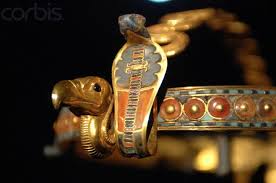

How do we know that R.O. Faulkner's translation of the Ancient Egyptian Pyramid Texts is correct?
Click here for the discovery and decoding of hieroglyphics and the discovery of the Tomb of Tutenkhamen, among the greatest discoveries in Egyptian Archeology.
*******************************************************************************
Had the Rabbis of old known about the Ureus, they might have added some text such as the following to the Midrashim.
מניין שהיה לפרעה תפילין? שנאמר: ושמת את הנשר ואת הנחש על ראשך, למען ידעו כל מצריים שאתה המושל והשליט : וכל זר לא תלבש בו
מדרש גרשון
Translation: From where do we know that Pharoah wore Tefillin? As it says, and you shall put the eagle and the snake on your head, in order that all of The Egyptians will know that your are the ruler and unmistakable head of state. And no commoner shall wear it.
GP Commentary: This fictional passage emphasizes the complete despotic power of the Pharoah and the ruling class of Egypt. For a deeper understanding of the Ureaus and its historical importance, READ HERE.
Now consider Tefillin:
The Reasons for the Mitzvot, part one
דברים פרק ד
ה) רְאֵה לִמַּדְתִּי אֶתְכֶם חֻקִּים וּמִשְׁפָּטִים כַּאֲשֶׁר צִוַּנִי יְקֹוָק אֱלֹהָי לַעֲשׂוֹת כֵּן בְּקֶרֶב הָאָרֶץ אֲשֶׁר אַתֶּם בָּאִים שָׁמָּה לְרִשְׁתָּהּ:
ו) וּשְׁמַרְתֶּם וַעֲשִׂיתֶם כִּי הִוא חָכְמַתְכֶם וּבִינַתְכֶם לְעֵינֵי הָעַמִּים אֲשֶׁר יִשְׁמְעוּן אֵת כָּל הַחֻקִּים הָאֵלֶּה וְאָמְרוּ רַק עַם חָכָם וְנָבוֹן הַגּוֹי הַגָּדוֹל הַזֶּה:
Behold I have taught you statutes and ordinances to perform in the midst of the land which you are coming to inherit. Be careful and do them because this is your wisdom and understanding in the eyes of the nations who will hear of all of these statutes and say "What a great nation this is." (Deuteronomy 4:5-6)
************************************************************************************
רמב"ן דברים פרק ד
(ה) וטעם ראה למדתי אתכם - ראה שאני מלמד אתכם היום, כמו שאמר אשר אנכי מצוה אתכם היום (להלן יא יג) ואשר אנכי נותן לפניכם היום (בפסוק ח). או יאמר "למדתי", מפני שהזכיר "לעשות כן בקרב הארץ", כלומר ראה בעת בואך לארץ שלמדתי אתכם חקים ומשפטים כאשר צוני ה' אלהי. והנה מתחלה דבר על הדבר שהיא כלל לכל עשה ולא תעשה, ועתה יזהיר בחוקים שהם גזרותיו ובמשפטים שהם הדינים, כי אלו הם צריכין חזוק יותר, מפני העלם טעם החקים, ומפני כי במשפט יעמידו ארץ. ואמר לעשות כן בקרב הארץ - להזהיר על כולם, כי יש חוקים רבים ומשפטים שאינן נוהגין בחוצה לארץ. או ירמוז שעיקר המצות כולן בארץ כמו שרמזתי בסוד הארץ (ויקרא יח כה)
ואמר כי בחוקים ובמשפטים תועלות גדולות, שהם תפארת לעושיהם מן האדם, ואפילו שונאיהם ישבחו אותם בהם. ועוד שהם תועלת גדולה שאין כמותה שהשם יהיה קרוב להם בכל קראם אליו, וכן העמים יתבוננו בזה ידעו כי החוקים נעשים בחכמה ובינה לקרבה אל האלהים וייראו מהם, וזהו שאמר כי מי גוי גדול - ועוד שהחוקים והמשפטים בעצמם הם צדיקים, ישרים וטובים בישוב העם והמדינות
Nachmanides:
And it says these statutes and ordinances have great value, because these are the adornment for who those do them, and even their enemies will praise them for this. Moreover, they have great value since there is nothing comparable to show that G-d is close to them in his reaching out to them. And the nations will reflect upon this and know that these statutes are done with wisdom and understanding to bring (Israel) close to G-d and to be careful in their observance, and this is what is meant by the passage: " What great nation…"and further that these statutes and ordinances themselves are righteous, straight and good for the security of the lives of the nation (of Israel) and of the other nations.
*************************************************************************
Maimonides:
And Scripture says, That, when they hear all these statutes, shall say: Surely this great nation is a wise and understanding people (Deut. 4:6)_. Thus it states explicitly that even all the statutes will show to all the nations that they have been given with wisdom and understanding. Now if there is a thing for which no reason is known and that does not either procure something useful or ward off something harmful, why should one say of one who believes in it or practices it that he is wise and understanding and of great worth? And why should the religious communities thank it is a wonder? Rather things are indubitably as we have mentioned: every commandment from among these 613 commandments exists either with a view to communicating a correct opinion, or to putting an end to an unhealthy opinion, or to communicating a rule of justice, or to warding off an injustice or to endowing men with a noble moral quality, or to warning them against an evil moral quality. Thus (all the commandments) are bound up with three things: opinions, moral qualities, and political civic actions.
(Rambam, Guide to the Perplexed, Part III, Chapter 31. )
****************************************************************
Rabbi Isidore Twersky on this passage of the Rambam:
Hukkim are messages which must be deciphered and decoded; they appear undecipherable only for lack of knowledge, insight, and sensitivity. There may be setbacks along the road , and one may reach impasses in analysis, but the cumulative trouble and frustration should not discourage the inquirer. In sum, the Torah has stated unequivocally that statutes are purposive and must be properly interpreted, temporary confusion and uncertainties notwithstanding. This passage insists, furthermore, that the interpretation must be of such a nature that it will have a universal resonance and impress all the nations. It is not merely another Scriptural proof but it provides basic directives for the unfolding of the entire intellectual enterprise. The reasons must be univerally intelligible and persuasive.
(R. Isidore Twersky, Introduction to the Code of Maimonides, p. 385-386)
The Reasons for the Mitzvot, part two
According to the Rambam, there are some parables in which "each word has a meaning." There are likewise some commandments concerning which "the particulars of, and conditions for, them have become clear." As a matter of fact, Maimonides suggests that more particulars could be understood if we have more historical information; specifically, particulars concerning sacrifices and uncleanness. Furthermore, he completes the parallel by applying the same thesis to stories: "Just as, according to what I have told you, the doctrines of the Sabians are remote from us today, the chronicles of those times are likewise hidden from us today. Hence if we knew them and were cognizant of the events that happened in those days, we would know in detail the reasons of many things mentioned in the Torah"
Maimonides: Guide for the Perplexed, III, 26, II, 49
as found in Isidore Twersky:Introduction to the Code of Maimonides, p. 389.
Click here for The Ureaus in Wikipedia:
click here for: Historical Origins and Continued Sanctity
Click here for Laws of Tefillin in the Mishneh Torah
Click here for The Reasons for the Mitzvot Part 1
Click here for the story of Champollion, the first one to decipher hieroglyphics. Then view the original footage of the opening of the tomb of Tutankhamen in 1923. This was one of the greatest discoveries in Egyptian Archeology.
The Discovery of Ancient Egypt
The Discovery of Ancient Egypt, takes you on a video tour in historical sequence to learn:
- Who first deciphered hieroglyphics?
- What is the Tomb of Tutankhamen and how was it discovered?
- How was Napoleon responsible for the beginnings of modern Egyptian Archeology?
There is a story here which should be seen and heard by all. The story is out there for the taking, but if you are not looking for it, you may never find it.
Dr. David Neiman introduces The Rosetta Stone:
The Rosetta Stone of Ancient Egypt
Carl Sagan on Champollion & the Rosetta Stone part 1
Carl Sagan tells the story of Champollion, the man who deciphered the Rosetta Stone:
Napoleon's Egyptian Campaign
Bob Brier, a Napoleon enthusiast, shows us how Napoleon revolutionized the field of Egyptian Archeology:
The Discovery of King Tutenkhamun's Tomb
Original Film Footage of the Discovery of Tutenkhamun's Tomb
****************************************************************************************************
It is from the tomb of Tutankhamen that we see the Ureaus in its original, pristine form, with all of its colors and artistic splendor. It was buried and hidden from grave robbers for 3000 years.
The Name of G-d Is Called Upon Thee
דברים פרק כח:י
וְרָאוּ כָּל עַמֵּי הָאָרֶץ כִּי שֵׁם יְקֹוָק נִקְרָא עָלֶיךָ וְיָרְאוּ מִמֶּךָּ
תרגום יונתן דברים פרק כח
וְיֶחֱמוּן כָּל עַמְמֵי אַרְעָא אֲרוּם שְׁמָא דַיְיָ חָקִיק בִּזְמַן דִתְּפִילִין עֲלָךְ וִידַחֲלוּן מִנָךְ:
אור החיים דברים פרק כח
ואומרו וראו כל עמי הארץ וגו' גם זה הוא מכוון כנגד שמירת מצות לא תעשה, כי כל זמן שהאדם שומר עצמו מהעבירות אין צלם אלהים עובר מעל פניו וכל הנבראים אדם ובהמה מזדעזעים ממנו משא"כ המתעב מעשיו מעבירין ממנו הצלם וכמאמר קין (בראשית ד' י"ד) והיה כל מוצאי וגו':
תלמוד בבלי מסכת מנחות דף לה עמוד ב
+דברים כ"ח+ וראו כל עמי הארץ כי שם ה' נקרא עליך ויראו ממך. תניא, ר"א הגדול אומר: אלו תפילין שבראש. +שמות ל"ג+ והסרותי את כפי וראית את אחורי - אמר רב חנא בר ביזנא אמר ר"ש חסידא: מלמד שהראה לו הקדוש ברוך הוא למשה קשר של תפילין. אמר רב יהודה: קשר של תפילין צריך שיהא למעלה, כדי שיהו ישראל למעלה ולא למטה: וצריך שיהא כלפי פנים, כדי שיהו ישראל לפנים ולא לאחור.
רש"י מסכת מנחות דף לה עמוד ב
קשר של תפילין - שישים הרצועות על ראשו [בענין] שיהא +מסורת הש"ס: כעין+ דל"ת כדי שיהא שדי נראה עליהן דשי"ן נראה בקמט בית חיצונה שכפל הקלף כעין שי"ן ודל"ת נראה בקשר ויו"ד נראה באותו של יד כמין רצועה קטנה וראשה כפוף מעט כמין יו"ד.
שימני כחותם על לבך כחותם על זרועך כי עזה כמות אהבה קשה כשאול קנאה רשפיה רשפי אש שלהבתיה:

